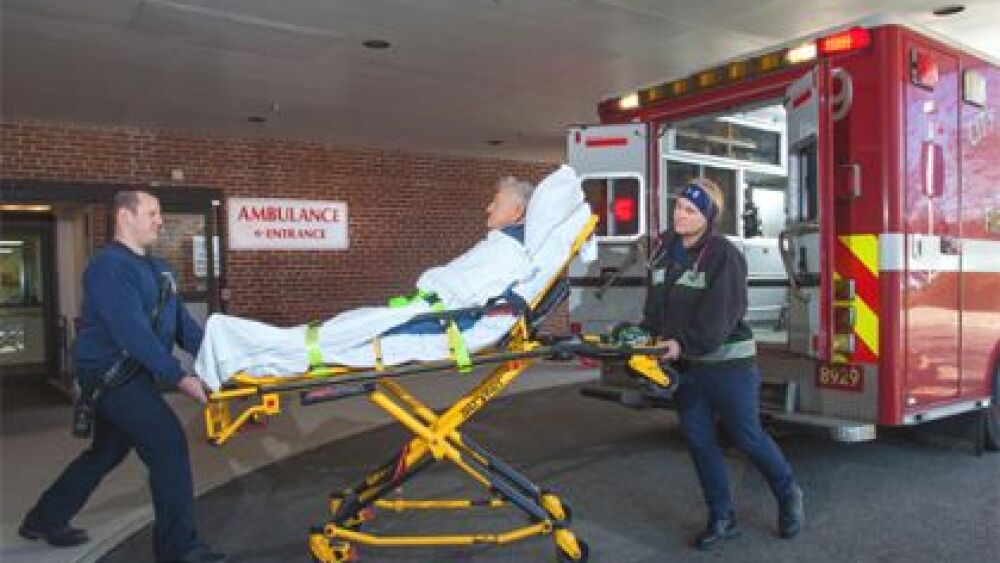By Kimberly Warren
The fast track to a positive outcome for a stroke patient starts with early recognition of stroke symptoms and calling 911 for assistance by trained EMS providers, followed by rapid transport to a hospital that is capable of providing all aspects of stroke care.
EMS personnel are collaborating with the Bon Secours DePaul Medical Center in Norfolk, Va. to improve stroke outcomes along the complete continuum of stroke care. This is how they are working together:
1. Transport patients to a stroke center
In a growing number of states, including Virginia, stroke center certification determines the facility to which a patient should be taken for the most appropriate care when a stroke occurs. Norfolk Fire-Rescue is the EMS provider that delivers many patients who are presenting with stroke-like symptoms to Bon Secours DePaul. The hospital, which is part of the Bon Secours Hampton Roads Health System, recently received certification by DNV GL Healthcare as a Comprehensive Stroke Center. This prestigious designation reflects the highest level of competence for treatment of patients who have experienced a serious stroke.
“With stroke care, you must have not only the best clinicians and resources, but also the ability to act quickly in an organized, efficient manner because of the time-critical nature and complexity of a stroke,” said John R. Baker, M.D., Ph.D., medical director of the Bon Secours Hampton Roads Neurovascular Center and the Neuroscience ICU. “This certification from DNV GL validates all the efforts we have put into our stroke care program in order to ensure the health and safety of our patients.”
2. Prehospital notification
Stroke care begins before a patient arrives at the hospital. “A prehospital alert is sent to DePaul via radio. Upon arrival, a nurse and physician meet us at the door,” said Captain Greg DeYoung, quality assurance officer for Norfolk Fire-Rescue. “In many cases, our EMS team will accompany the patient to the CT scanner and then we’ll turn things over to DePaul staff.”
3. Feedback to EMS
DeYoung noted that Bon Secours provides candid feedback about the patient’s outcome and about the door-to-CT times that are so vital to improve stroke outcomes.
“We pass all of this information along to our EMS providers, which they really appreciate,” DeYoung said. “In addition, DePaul representatives have visited our stations to get the word out about their stroke center designation. This two-way communication is key, especially for stroke care.”
4. Communication builds trust
Travis Mitchell, the system EMS coordinator for Bon Secours Hampton Roads Health System, emphasized that an open dialogue establishes trust between the hospital and EMS teams.
“We want a clear conduit for information to flow both ways, and Bon Secours has been a trend-setter in proving feedback to EMS providers,” Mitchell stated. “Bon Secours also encourages our participation on a variety of regional EMS committees that develop protocols and procedures for stroke care and other emergency conditions.”
5. Continuous education
In addition, Bon Secours is actively engaged as a partner in health care education throughout the Hampton Roads region. Mitchell commented that EMS providers are curious about the treatment that is administered to stroke patients at the hospital, and they are eager to get additional training about this life-threatening condition.
“EMS providers are required to attend classes to sharpen their skills, so we are always prepared to offer training about advanced stroke care,” he said. “We believe that education strengthens our relationship with first responders.”
Bon Secours also supports the Virginia EMS Symposium and several other regional EMS conferences.
“Quite simply, EMS is an integral part of our stroke care team at Bon Secours DePaul,” Mitchell said. “Working together, health systems and EMS systems can improve stroke outcomes nationwide through education, communication and collaboration.”
About the author
Kimberly Warren RN, MSHA, FACNA, BSN, BS, is the Administrative Director of Neuroscience for the Bon Secours Hampton Roads Health System.












